As the sport of MMA evolves, fighters are becoming better and better athletes. In order to compete at the highest level, a well-developed strength training plan is needed. Neglecting strength training completely is likely to have you being left behind the pack.
Strength training for MMA should be performed twice per week as to not interfere with MMA training. The focus should be on developing both high-velocity and maximal strength in order to maximize performance when striking and grappling.
It’s also important to consider the common injuries that occur during an MMA fight and MMA training in order to mitigate the injury risk.
Best Strength Training Exercises For MMA
There are hundreds of Instagram and TikTok “gooroos” shilling you entire training programs with “specific” MMA exercises. They don't work.
Specificity exists on a spectrum. I’m not one to say there aren’t more specific exercises than others. But our goal in the gym is to enhance strength, speed, and power (and sometimes muscle mass). Most of these exercises you’re fed on social media don’t have the loading or intent behind them to elicit ANY adaptation.
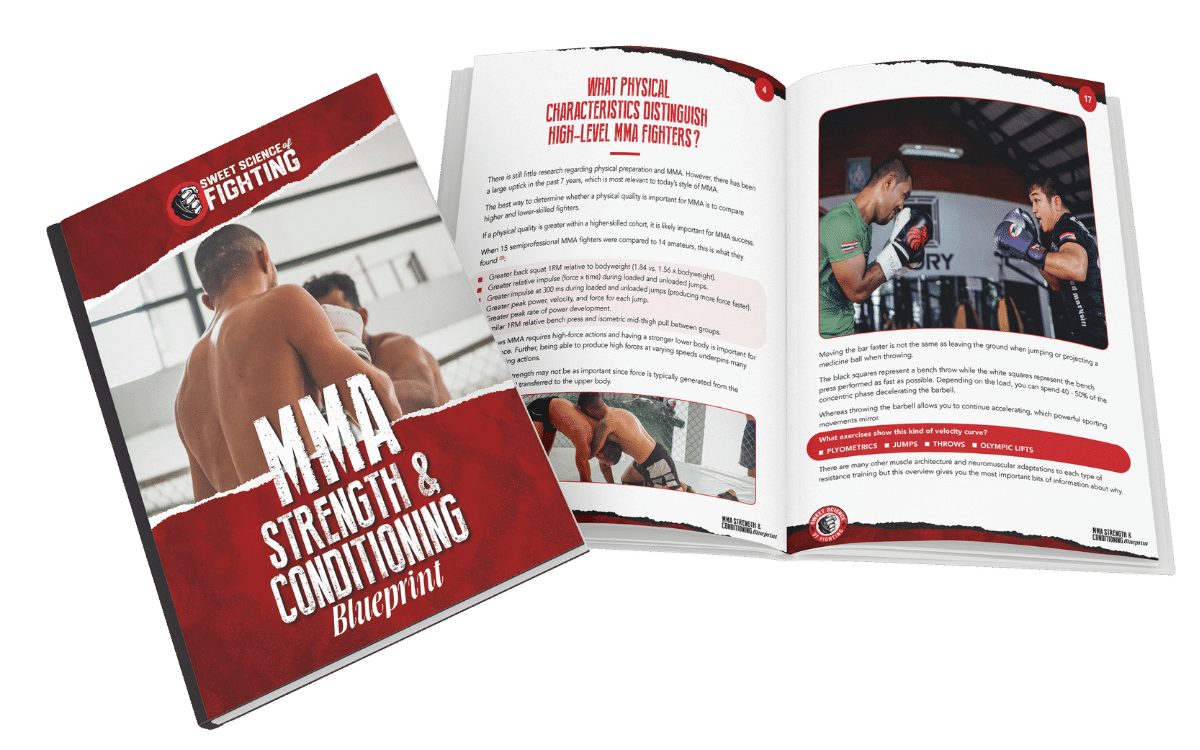
How to Dominate Every Fight with Raw, Explosive Power No One Can Match
Discover the underground blueprint that has quietly turned MMA hopefuls into legends, using nothing but sheer, brute force and bulletproof conditioning techniques.
And that’s all it really is. Are we providing the body with a strong enough stimulus to adapt?
The easiest way to think about exercise selection is to start with the 7 basic movement patterns:
- Squat
- Hinge
- Push
- Pull
- Lunge
- Twist
- Carry
For MMA, I would add:
- Throw
- Jump
- Olympic lift
Should every session have all of these? No. But your training week should cover most of these most of the time. Here's some examples for each category I like to use.
Front Squat
The squat is considered the king of lower body exercises. It targets the glutes and quads but is limited by your back strength. You have many variations to play with, such as back squats, front squats, and even zercher squats.
What you use depends on your injury history, stage of training, and what you feel most comfortable performing. I’m a big fan of the front squat, and here is how to do it:
- Set under the bar and position it across the front of your shoulders. Choose a grip: either a clean grip (fingers under the bar) or a cross-armed grip (arms crossed over the bar), depending on your mobility.
- Keep your elbows high to create a 'shelf' for the bar on your shoulders. Unrack the barbell and step back.
- Begin the squat by pushing your hips back slightly and bending your knees simultaneously to lower your body straight down.
- Keep your chest up and your elbows high throughout the descent.
- Aim to go as deep as your flexibility and mobility allow, ideally until your butt touches your calves in the bottom position.
Romanian Deadlift
While the deadlift is great, the Romanian deadlift is a true hip hinge movement. To perform these correctly, always start from the top. So either take the bar out of the rack or deadlift the weight first.
- Slowly push your hips back as far as you can without bending your knees any further.
- Your knees won't be completely straight. They'll be slightly bent. As soon as your hips stop moving backward, stop and thrust the hips forward to return to the starting position. This means you'll only get to just below your knees if you do this correctly.
Thick Bar Bench Press
My advice is to replace all your upper body pressing with the thick bar. You'll thank me later. The way you bench press with the regular barbell is the same as a fat bar.
- Setup tight under the bar with your feet planted and tension through your legs and hips. Set your shoulders blades back and down into the bench.
- Unrack the bar by performing a pullover motion. Slowly descend the bar to your chest with your elbows 45 degrees from your torso.
- Violently press the barbell to the starting position using your legs to help.
Weighted Pull-Up
Pull-ups should be a staple within your wrestling workouts. For variation, they can be done with an underhand (chin-up) or overhand (pull-up) grip. You can level them up further by using towels to strengthen your grip. Here’s how to do it:
- Use a dip belt to hang plates between your legs. You can hold a dumbbell between your feet if you don't have a dip belt.
- Grip the pull-up bar with palms facing away from you. Your grip should be slightly wider than shoulder-width apart.
- Create a big chest from the dead hang position like you’re trying to face your upper chest to the chin-up bar.
- Pull yourself up by driving your elbows to your ribs while maintaining a big chest. If you’re strong enough, your chest should touch the chin-up bar.
- Slowly lower yourself back to the dead-hang position.
Step Up
I wasn't a fan of the step up until recently. It is an epic lower body movement to develop leg strength and power. Having a barbell on your back is better than holding dumbbells in my experience. Here's how to do it:
- Use a box that allows your thigh to be parallel with the floor. Step onto the box and forcefully drive your foot down and extend your leg.
- Perform all reps on one leg before changing legs.
Landmine Rotation
The landmine rotation is easily my favorite rotation exercise when it comes to MMA. Being able to resist heavy loads while rotating and exploding to the starting position will give you some real power in your stand up game. I hate seeing this exercise performed with a stationary body and only the arms moving side to side.
Turn your feet and hips with the exercise so you can load not just the trunk, but the hips and legs. This is where you will get that crazy power.
Sandbag Bearhug Carry
Like sandbag loading, the bearhug carry is a brutal Strongman exercise challenging your entire body from your hips to your hands. You can make incredible endurance improvements with this exercise when done consistently. Here’s how to do it:
- When the sandbag is flat on the floor, you must wedge your hands under each side. You'll need to roll the sandbag back and forth over each hand to get your hands and forearms around the sandbag.
- From this position, squat down so you can use as much of your legs as possible to stand up with the sandbag.
- You will likely have to adjust the sandbag on the way up with a little hip bump and readjustment of the hands. You can use a monkey, seatbelt, Gable, butterfly, or S grip.
Medicine Ball Rotational Throw
MMA fighters need to use medicine balls more in their training. They should be a staple no matter the time of year or how far from a fight you are. There are many variations you can use but this is a great rotational version.
The movement should come from your legs and hips to whip the ball as you throw. Not by making it an upper body only throw.
Jump Squat
Jumping is an excellent alternative to the Weightlifting movements. It has no learning curve, and you can express power with varying loads. You can use a barbell on your back or hold a trap bar or dumbbells by your side.
Jumping improves your ability to produce force quickly, which is a key requisite for MMA performance. Here’s how to do it:
- Dip into a quarter squat position. The faster you can turn the descent into the ascent (eccentric to concentric), the better you will train the ability to produce force quickly. Push through your entire foot and drive with your legs as you do this.
- Continue driving with the legs and onto your toes. Absorb the impact when landing by slightly bending the knees.
Hang Clean High Pull
Olympic lifts are most beneficial for athletes manipulating other human beings. Like MMA fighters. But they can be hard to learn or injuries can prevent some of the positions. The derivatives like the hang clean high pull give you the benefits of the lifts without needing mobility or a steep learning curve.
- Descend into the hang position with your shoulders over the bar and your weight through your full foot.
- Push with your legs and extend into a tall standing position as the bar brushes up your thighs.
- Triple extend your hips, knees, and ankles as you violently shrug and drive your elbows vertically.
MMA Strength Profile
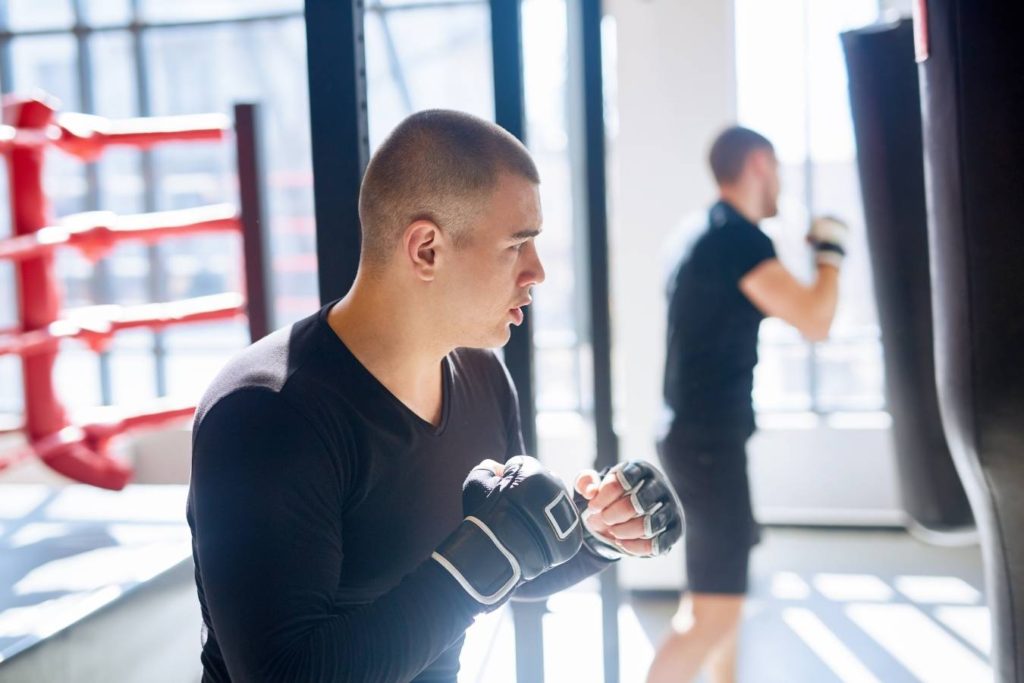
With the birth of the UFC Performance Institute, a greater breadth of research has been done in the sport of MMA.
This means we have access to athletic profiles of fully professional MMA fighters. My article “Strength Standards For MMA” breaks down the strength profiles of UFC fighters.
To sum the article up briefly, MMA fighters need a high level of reactive strength (reactive strength index >2.6), explosive or elastic strength (vertical jump >50 cm), and maximal strength (deadlift > 2.5x bodyweight).
Reactive strength players a large role in striking speed while elastic strength highly relates to powerful takedowns.
This kind of high-velocity strength training can potentially increase the number of Type IIX muscle fibers and improve the ability to produce force quickly.
Maximal strength positively influences all strength qualities. Not to mention maximal strength training can desensitize the inhibitory mechanism that decreases force output. Therefore, greater force can be produced.
Balancing these strength qualities in training is how you can optimize performance. Depending on your athletic profile, you may emphasize one over the other.
To dive deeper into MMA strength profiles, we can compare higher and lower performers.
If higher-level MMA fighters possess a physical attribute greater than lower-level fighters, it suggests that quality is important to MMA performance.
If there are no differences between levels, we can conclude that characteristic does not differentiate between high- and low-level MMA fighters. What counts as a high-level MMA fighter? In these studies, it was semi-professional fighters with a verifiable record on Sherdog with a >50% professional win record.
Lower-level fighters had win records <50% or were amateurs. When comparing strength and power, high-level MMA fighters displayed greater 1RM squat strength (1.84 ± 0.23 vs. 1.56 ± 0.24 kg/BM), but no differences were found for 1RM bench press [3].
This highlights the importance of lower body strength in MMA, which differs from BJJ, where upper body strength seems more important [4]. The difference is likely due to pure grappling vs. mixing striking and grappling.
Higher-level MMA fighters also possessed greater peak force, velocity, and power during the squat jump with loads of 0%, 25%, 50%, 75%, and 100% of body weight. This indicates MMA fighters must be able to express high forces and velocities over the entire force-velocity spectrum.
When breaking down the kinetics of the jump, higher-level MMA fighters produce greater concentric force, velocity, and power. Further, they display a greater modified reactive strength index due to less time in eccentric contraction [5].
Sounds like a lot of scientific jargon, I know! But essentially, they could produce greater strength, speed, and power in shorter time frames. High-level fighters, utilizing superior elastic qualities, didn't dip as low when jumping. This is vitally important in MMA as you have limited time to execute techniques before an opponent can react to defend or evade.
Legendary Russian sports scientist Yuri Verkhoshanksy has an excellent visual representation of this concept he calls the “working effect.” It’s a force-time graph representing impulse, which is the product of force and time.
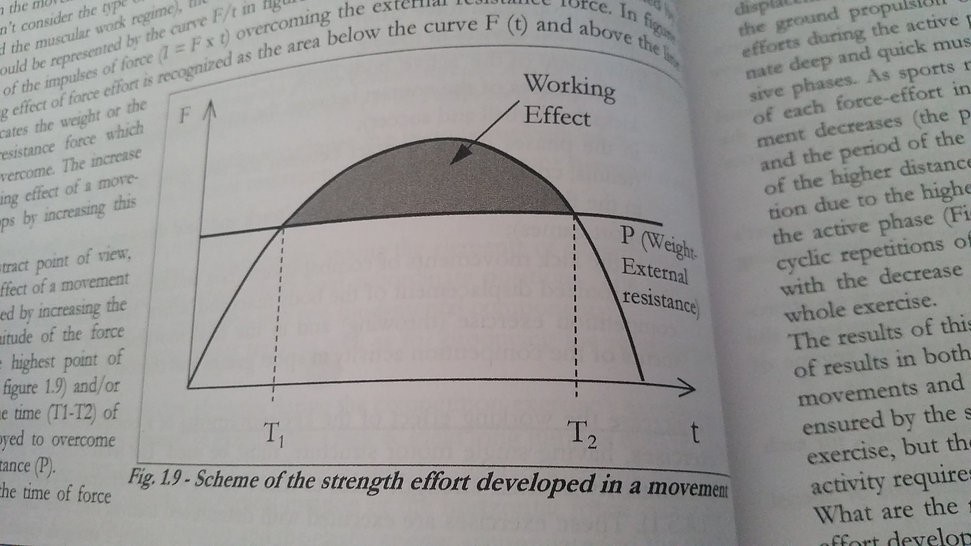
Impulse illustrated for you visual thinkers
I go into more detail in my “Physics of Fighting” article. But to keep this simple, Verkhoshanksy defines the working effect as “the amplitude of the impulses of force overcoming the external resistance force.”
This could be bodyweight, external opposition, or external implement. But what you need to know is this:
An increase in the working effect requires increasing maximal force output and/or increasing time (T1-T2 in the diagram above) of the force generated to overcome the external resistance (P).
However, increasing the time to produce force is not advantageous to the MMA fighter. Taking longer to punch, kick, or shoot makes it easier for your opponent to slip, block, or sprawl.
Therefore, MMA fighters must develop the ability to produce maximum force in shorter time frames, as demonstrated by the high-level MMA fighters in this study. There are many ways of doing this through various eccentric training modalities. Professor John Cronin covered them in our podcast episode below.
Further, the program examples at the end of this article will give you an idea of how this can be developed with simple training methods.
But should all MMA fighters train like this? Potentially not. It may be better for weaker fighters (defined as having squats <1.6 relative to bodyweight) to focus on heavy strength training before emphasizing power movements.
For a 70 kg fighter, that would mean squatting at least 112 kg. Once you’ve achieved a decent level of strength, continuing to develop maximal strength with lower volume and increasing the volume of various power exercises will help build qualities across the force-velocity spectrum.
Strength Assessments For MMA
Just because you reach a certain testing benchmark does not mean you’re suddenly a better fighter. However, becoming stronger and faster with better conditioning can help realize your skillset.
Here’s some basic thresholds that can be helpful for dictating the direction of your training.
- Back squat >1.6 x bodyweight
- Vertical jump >45 cm (17.7”)
- Reactive strength index (40 cm box) >2.5
- Maximal aerobic speed >4.2 m/s
These are what I’d consider absolute minimum thresholds to hit for most fighters based on research and my own experiences. Here’s how a decent range will look:
- Back squat: 1.6 - 2.0 x bodyweight
- Vertical jump: 45 - 50 cm (17.7 - 19.6”)
- Reactive strength index (40 cm box): 2.5 - 3.0
- Maximal aerobic speed: 4.2 - 4.5 m/s
Does this mean your physical training tasks are done? No, these are within the average range of most UFC fighters.
But it gives a few basic benchmarks to aim for. How do you measure each one?
Back Squat: Multiply your bodyweight by 1.6 - 2. It should equal or be under the load you squatted. For example, if you weigh 200 lbs, you should be able to squat between 320 - 400 lbs.
Vertical Jump: Stand against a wall and reach your hand marking the wall with chalk. Jump and mark again. Measure the distance. Not an error proof exercise but an easy no equipment field test. The My Jump Lab is the best phone app for this.
Reactive Strength Index (RSI): Stand on a 40 cm box, step off. When you hit the ground, jump as high as you can as quickly as possible. Ground contact time should be minimal. I like to aim for <250 ms on the ground which you can measure with the My Jump Lab app. There’s a learning curve to this exercise. Here’s what it looks like:
How Do Testing Results Influence Your Program?
Most people test then forget about it. Testing must influence your training. Here’s some general guidelines you can follow:
- Under strength/power thresholds: Focus on maximal strength with low-volume extensive plyometrics.
- In range: Blend of maximal strength and power-based exercises.
- Above thresholds: Minimal/low volume of maximal strength with higher volumes of power-based exercises.
You may have a 2 x bodyweight squat but lack reactive strength. In this case, you’d perform most of your training towards various plyometric exercise with less maximal strength volume as an example.
Fundamentals Of Strength Training For MMA
Everything we do in the gym to prepare for MMA hinges on this simple graph (and other adaptations, but I like this visual):
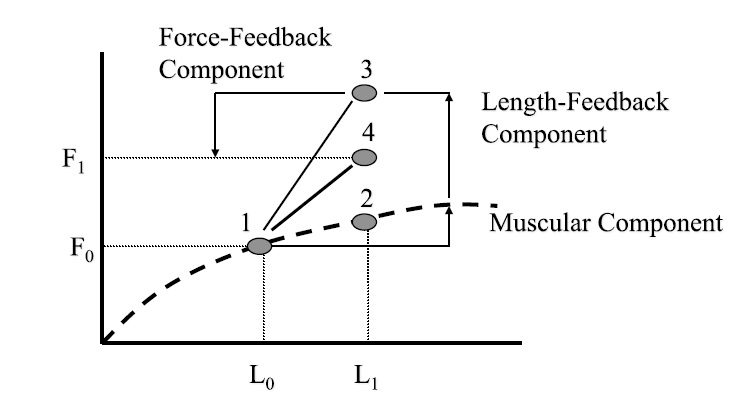
It’s taken from a research paper by Paavo Komi [6]. It shows the change in force by change in muscle length. Essentially, the force produced during a muscle contraction.
For a given change in muscle length (e.g., a bicep curl), we have an increase in force generated from circle 1 to circle 2. We then have the length feedback component known as the muscle spindles.
It is sensitive to the rate of stretch and "excites" the muscle to increase force production to circle 3. But the force feedback mechanism, known as the Golgi tendon organ, doesn't like this.
It pumps the brakes as a protective mechanism to dampen force production, leaving you at circle 4 for the final force output. The goal is to raise circle 4 as high as possible for a given change in muscle length.
How does heavy strength training and jumps/plyometrics help?
- We can enhance the sensitivity of the muscle spindles through plyometric training. Improving sensitivity increases excitation and, therefore, force generation.
- Maximal strength training desensitizes the Golgi tendon organ so it doesn't pump the brakes so early.
Untrained individuals have the Golgi tendon organ kick in too early, and this is why beginners can't express their maximum outputs in the gym. Desensitize this response by lifting heavy loads.
This is one of the adaptations showing why you MUST perform heavy resistance training AND high-velocity strength training.
Here’s another graph by Kraemer and Newton, further illustrating my point and why I’m constantly preaching you can’t follow a bodybuilding or Powerlifting program for MMA [7].
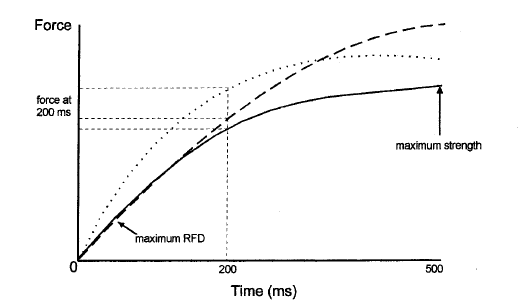
All sporting movements are constrained by time. As mentioned earlier on the “working effect,” we must improve the ability to generate high forces in short time frames. Now, this doesn’t apply as greatly to grappling actions where slow, grindy movements give almost infinite time to apply forces compared to striking actions.
Boxing and Muay Thai techniques occur within 50 - 300 ms [8]. Hence the importance of high-velocity strength training and plyometric exercises.
The graph shows different training types.
- The solid line represents untrained subjects.
- The dashed line represents heavy resistance-trained subjects (e.g. Powerlifters).
- The dotted line represents light resistance power-trained subjects (e.g. track athletes).
While heavy resistance-trained subjects display the greatest force, they don’t display the greatest force generation at lower time points, as denoted by the 200 ms mark.
Again reinforcing the point of performing heavy resistance training AND power training. But can’t you just lift the bar faster as many strength coaches will say?
Moving the bar faster is not the same as leaving the ground when jumping or projecting a medicine ball when throwing.
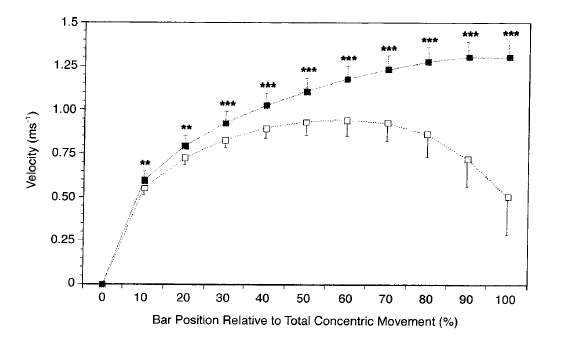
The black squares represent a bench throw while the white squares represent the bench press performed as fast as possible. Depending on the load, you can spend 40 - 50% of the concentric phase decelerating the barbell.
Whereas throwing the barbell allows you to continue accelerating, which powerful sporting movements mirror.
What exercises show this kind of velocity curve?
- Plyometrics
- Jumps
- Throws
- Olympic lifts
There are many other muscle architecture and neuromuscular adaptations to each type of resistance training but this overview gives you the most important bits of information about why.
Why Full Range Of Motion Is King
Muscle fiber contractile velocity is proportional to its length. Meaning how quickly your muscles contract is determined by the number of sacromeres (blocks of muscle fibers) are in a row. Muscle fiber type also plays a role here.
Sarcomeres shorten at 2x the muscle fiber length per second [9]. For example, having 10 sarcomeres in a row would shorten at 20 fiber lengths/second, whereas 5 sarcomeres would only shorten at 10 fiber lengths/second.
How do we add more sarcomeres? Eccentric training is a potent stimulus for this. Think Nordic curls for the hamstrings and weighted negative pull-ups for the upper body.
But full range of motion lifting is another method that has been shown to be superior to partial ranges of motion lifting [10].
Contractile velocity isn’t the only benefit of increasing sarcomere length. You shift the angle of peak torque up and to the right, meaning you produce more force at longer muscle lengths [11].
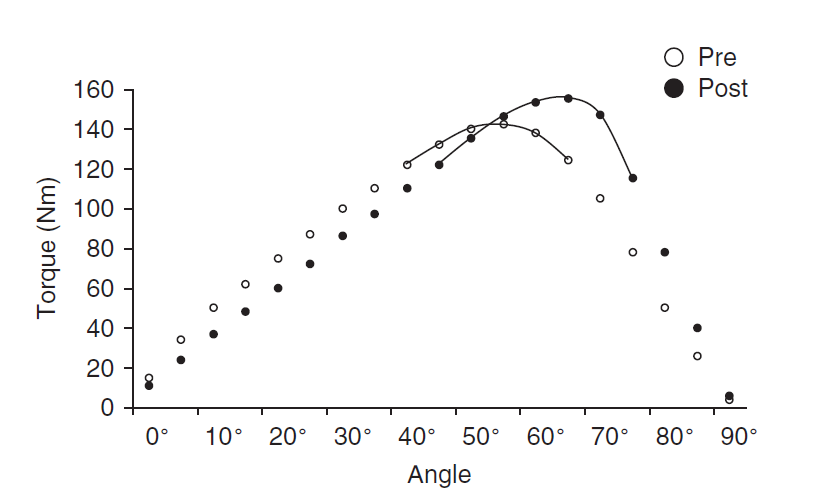
This has the potential to reduce your risk of injury in susceptible muscle groups like the hamstrings.
It’s why full range of motion resistance training IS mobility training. And no amount of static stretching will get you there (effectively).
Strength Training Program Design For MMA
For a busy MMA athlete, twice a week in the gym is more than enough. It’s all you have time for anyway. If you’re a recreational MMA athlete who goes to class for the cardio and social benefits and wants to look good, then three to four days in the gym is potentially better.
But I’m going to assume most of you reading this fall into the first camp. MMA fighters who’s main focus is getting better at MMA.
Since you’re in the gym twice a week, they should be full-body sessions. Upper/lower splits can work and, in my experience, can be quite good for older athletes (if you’re careful with the volume).
But full body sessions allow you to hit muscle groups twice a week, which is generally superior for strength development.
How should these sessions look? Here’s a template you can follow:
- Warm-up circuit
- Jumps/plyometrics/throws (don’t have to do all 3)
- Full body power exercise
- Heavy lower body
- Upper push
- Upper pull
- Core/carry/grip (don’t have to do all 3)
This is a basic template that can change depending on the main goal of training. However, you can use this if you’re after speed and power or maximal strength.
Just reduce your volume of speed and power exercises if strength is your goal and vice versa if you’re going after speed and power.
You can also make one day more heavy strength orientated and the second day more power orientated. Both work, up to you how you want to plan your training. I like the way I presented as if you can only get into the gym once that week, you’ve covered most of your bases.
You’ll notice I haven’t blocked strength training into only strength, or only hypertrophy, or only speed and power. It’s because I don’t believe in block periodization for mixed sports like MMA.
Yes, you can target one quality to maximize training effectiveness. But you blunt and diminish other important qualities you need for MMA. By the time you get to your 6th week of power/speed training, it’s been months since you’ve done any strength or hypertrophy exercise.
Yes, there is carryover between them all. But you need more than carryover. It’s why I take a vertically integrated approach to training. It means you cover all qualities within a training week.
It doesn’t mean you perform maximum-volume jumps and heavy squats. It means you prioritize the quality you want to improve and reduce the volume of the others. But they are always there.
If you spend 8 weeks in a hypertrophy phase, then 8 weeks performing maximum strength, you can’t hit the ground running in week 17 performing intense plyometrics and jumps. That’s a recipe for injury.
2 Day Strength Training Program For MMA
This strength training program is designed in two phases. Phase 1 is more of a general strength and power training program.
It has been developed to lead into the next phase which has more advanced exercise variations.
Phase 2 brings into the program the use of complexes. A complex is when you pair a strength movement where heavier loads are lifted, and therefore higher forces are produced, with a lighter loaded velocity exercise.
The most common example you may have seen before and performing squats then box jumps or bench press then clap push-ups.
The soviet researcher Dr. Verkhoshanksy explains it best in my opinion. He says to imagine what would happen if you lifted a half-full bottle of water when you thought it was full. There would be a mismatch between the force needed to pick the bottle up and the actual force required.
The idea is that the half-full bottle will move twice as fast as intended due to this mismatch. That is the theory behind performing a complex which you will find in Phase 2.
The scientific term is post activation potentiation or PAP for short.
Holistically, this MMA strength and conditioning program is a well-rounded program covering both high-velocity and maximal strength pretty evenly.
If you know you have a deficit in maximal strength or explosiveness, you may want to emphasize your weaker area which will likely carry over to all facets of your overall MMA strength and conditioning.
Phase 1
Day 1
Exercise | Set/Rep | Load |
|---|---|---|
A1) Box Jump | 2-4 x 3-5 | Cell |
B1) Med Ball Rotational Throw | 2-4 x 2-5/side | 3-6 kg |
B2) Band Pull Apart | 2-4 x 15-20 | Cell |
C1) Squat Variation | 2-4 x 3-6 | 70-88% 1RM |
D1) Bench Press | 2-4 x 3-6 | 70-88% 1RM |
D2) Row Variation | 2-4 x 5-8 | 65-80% 1RM |
E1) Swiss Ball Leg Curl | 2-3 x 6-10 | Cell |
F1) Sandbag Bearhug Carry | 2-3 x 20-40m | Cell |
Day 2
Exercise | Set/Rep | Load |
|---|---|---|
A1) Low Hurdle Hop | 2-4 x 6-10 | Cell |
B1) Med Ball Scoop Toss | 2-4 x 3-5 | 5-6 kg |
B2) Band Face Pull | 2-4 x 15-20 | Cell |
C1) Deadlift | 2-4 x 2-5 | 70-90% 1RM |
D1) Push Press | 2-4 x 2-5 | 70-90% 1RM |
D2) Pull-up | 2-4 x 5-10 | Cell |
E1) Lunge & Twist | 2-3 x 5-10/leg | Cell |
F1) Farmers Walk | 2-3 x 20-40m | Cell |
Phase 2
Day 1
Exercise | Set/Rep | Load |
|---|---|---|
A1) Maximal ISO Trunk Rotation | 3 x 6 sec/side | Cell |
A2) Med Ball Rotation Throw | 3 x 3-4/side | Cell |
B1) Snatch Grip RDL | 3 x 3-6 | 70-88% 1RM |
B2) Band Zercher Staggered Stance “Takedown” | 3 x 3-5 | Cell |
C1) Bench Press | 3 x 2-5 | 75-90% 1RM |
C2) Shock Med Ball Chest Throw | 3 x 3-5 | 3-4 kg |
D1) Weighted Chin-Up | 3 x 3-5 | Cell |
D2) Twisting Med Ball Slam | 3 x 2-3/side | Cell |
Day 2
Exercise | Set/Rep | Load |
|---|---|---|
A1) Overcoming Split Squat ISO Pins | 3 x 6 sec/side | Cell |
B1) Landmine Jerk | 3 x 2-3/side | Cell |
B2) Med Ball Plyo Step Punch Throw | 3 x 2-3/side | 2-4 kg |
C1) Partial Split Squat Pins | 3 x 3-5/side | Heavy |
C2) Continuous Hurdle Hop | 3 x 6-10 | Cell |
D1) Chest Supported ISO Plate “Bend” | 3 x 6 sec | Cell |
D2) Pendlay Row | 3 x 4-6 | Cell |
E1) Landmine Rotation | 3 x 5/side | Cell |
E2) Grip Variation | Cell | Cell |
3 Day MMA Weight Training Program
I would highly advise not to perform three days of MMA weight training. Strength training for fighters is to supplement technical MMA training. Meaning spending too much time in the gym can take away from your MMA sessions whether that is time or energy.
If you are in a training block far away from competition or you are trying to move up a weight class, then a third day in the gym may be warranted. This day however should be single joint isolation exercise emphasis as it is easy to recover from and designed to help build extra muscle.
While this wouldn't be considered specific MMA strength training, it allows you to get extra weight training volume without taking energy away from MMA workouts. Here is an example of how this extra day could look.
Exercise | Set/Rep | Load |
|---|---|---|
A1) Rear Delt Fly | 4 x 15-20 | Cell |
A2) Hanging Leg Raise | 4 x 10-15 | Cell |
B1) Cable Face Pull | 3 x 15-20 | Cell |
B2) Back Extension | 3 x 15-20 | Cell |
C1) Decline Push-Up | 3 x 10-15 | Cell |
C2) DB Hammer Curl | 3 x 8-12 | Cell |
D1) Lying Triceps Extension | 3 x 4-6 | Cell |
E1) Seated Incline DB Curl | 3 x 10 | Cell |
MMA Injury Profile
Two sets of data are in agreement with facial cuts, bruises, and altered mental states being the most common injuries during MMA fights [1,2].
Hand and wrist injuries were the next most common followed by knee injuries during MMA fights. Training tells a different story.
Knee injuries were the most common in training followed by shoulder and hand and wrist injuries. All of these injuries occur mainly when striking.
Grappling has a very low injury rate in both training and competitive fights.
How Many Days A Week Should You Strength Train For MMA?
It doesn’t take much to get stronger. As long as you’re consistent you will make progress. Juggling strength training and MMA training can be more complex than other martial arts.
MMA training has to juggle multiple striking and grappling disciplines within a week’s training. By the time you’ve covered all of your skills, finding the space to fit extra strength work is tough.
Depending on your phase of training, strength training should be performed 1-3 times a week. Two times a week will be the sweet spot.
Does MMA Training Build Muscle?
When you see big, jacked MMA fighters such as Yoel Romero, Paulo Costa, or even guys in the smaller weight classes like Henry Cejudo, you may come to the conclusion that MMA training helps to build muscle.
Sadly, this is not the case. The large amount of muscle mass seen on most fighters is from years of weight training and well-performed weight cuts before the fight.
MMA doesn’t provide adequate loading of the muscle through a full range of motion which is needed to maximize the hypertrophic response.
Instead, MMA mainly focuses on quick striking and isometric contractions when grappling. These are not enough to build muscle no matter the size of the opponent you’re training with.
Should MMA Fighters Lift Weights?
100% yes. There are no reasons why an MMA fighter shouldn’t lift weights. The old myths of lifting making you slow are gradually dying out of combat sports.
Strength training for MMA fighters has far too many benefits that cannot be ignored. From reducing the risk of injury, increasing the power of striking, and helping make you more dominant during grappling exchanges.
When MMA weight training is well designed, you will develop the ability to use it in the cage effectively against your opponents.
Dominate The Cage With Unrivaled Strength & Power
A strength training program specifically designed for MMA athletes to develop knockout power and manhandle opponents in the cage.
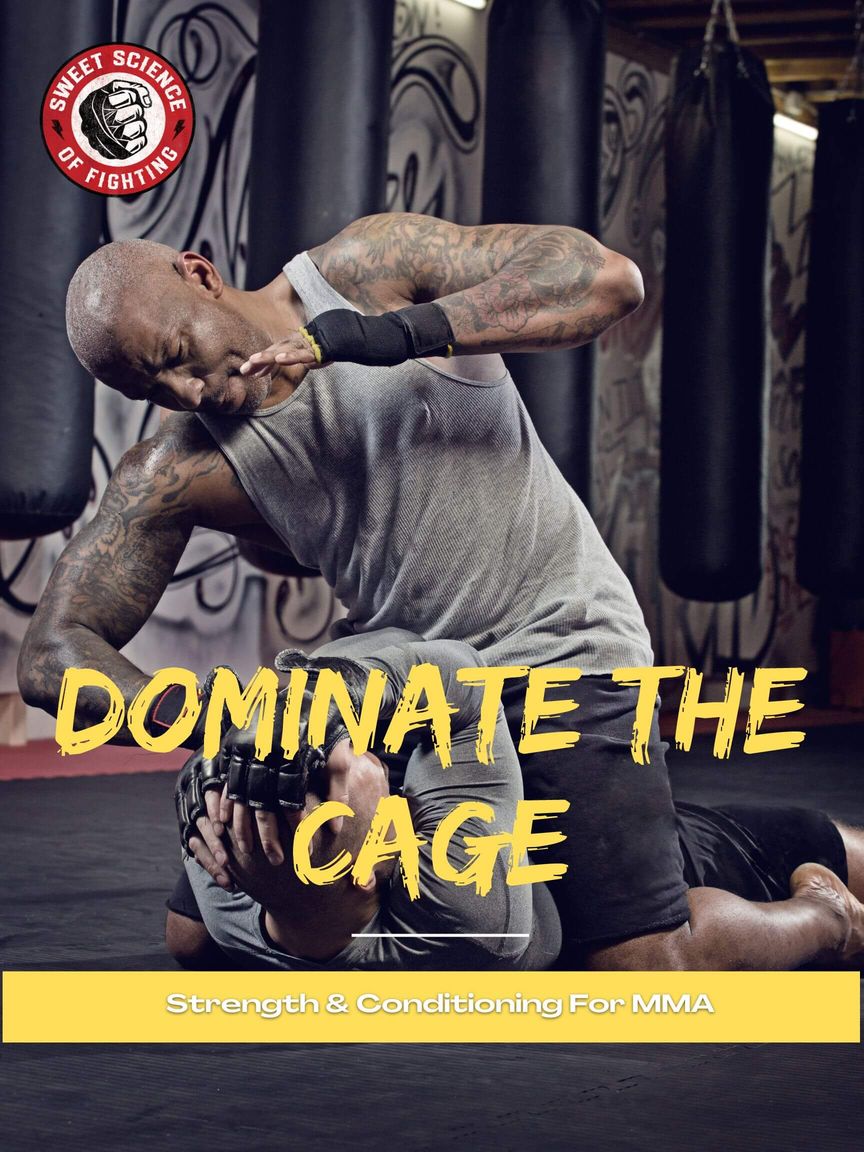

References
1. McClain, R., Wassermen, J., Mayfield, C., Berry, A. C., Grenier, G., & Suminski, R. R. (2014). Injury profile of mixed martial arts competitors. Clinical Journal of Sport Medicine, 24(6), 497-501.
2. UFCPI “Cross Sectional Performance Analysis And Projection Of The UFC Athlete.
3. James, L. P., Beckman, E. M., Kelly, V. G., & Haff, G. G. (2017). The neuromuscular qualities of higher-and lower-level mixed-martial-arts competitors. International journal of sports physiology and performance, 12(5), 612-620.
4. Marinho, B. F., Andreato, L. V., Follmer, B., & Franchini, E. (2016). Comparison of body composition and physical fitness in elite and non-elite Brazilian jiu-jitsu athletes. Science & Sports, 31(3), 129-134.
5. James, L. P., Connick, M., Haff, G. G., Kelly, V. G., & Beckman, E. M. (2020). The countermovement jump mechanics of mixed martial arts competitors. The Journal of Strength & Conditioning Research, 34(4), 982-987.
6. Komi, P. V. (1986). Training of muscle strength and power: interaction of neuromotoric, hypertrophic, and mechanical factors. International journal of sports medicine, 7(S 1), S10-S15.
7. Kraemer, W. J., & Newton, R. U. (2000). Training for muscular power. Physical medicine and rehabilitation clinics of North America, 11(2), 341-368.
8. Turner, A. N. (2009). Strength and conditioning for Muay Thai athletes. Strength & Conditioning Journal, 31(6), 78-92.
9. Cormie, P., McGuigan, M. R., & Newton, R. U. (2011). Developing maximal neuromuscular power: Part 1—Biological basis of maximal power production. Sports medicine, 41, 17-38.
10. Pallarés, J. G., Hernández‐Belmonte, A., Martínez‐Cava, A., Vetrovsky, T., Steffl, M., & Courel‐Ibáñez, J. (2021). Effects of range of motion on resistance training adaptations: A systematic review and meta‐analysis. Scandinavian journal of medicine & science in sports, 31(10), 1866-1881.
11. Bagley, R. J., Arevalo, A. J., Malyszek, K. K., Spencer, A. J., Rosengarten, J., Barillas, S. R., … & Galpin, A. J. (2016). Skeletal muscle phenotype and performance of an elite mixed martial artist. Medicine and Science in Sports and Exercise; Lippincott Williams & Wilkins: Philadelphia, PA, USA.

